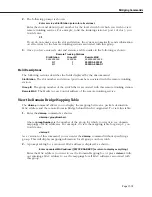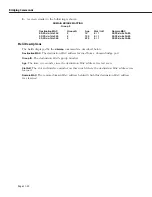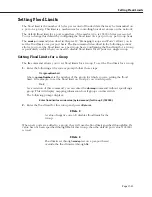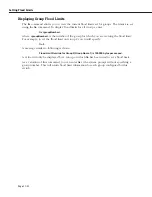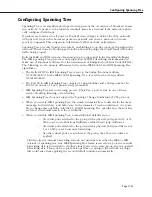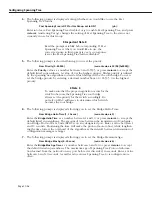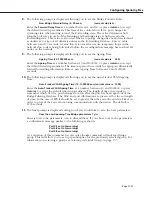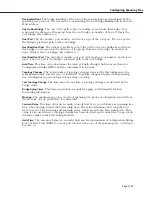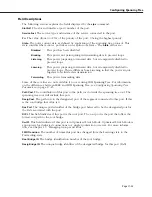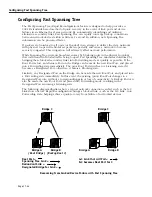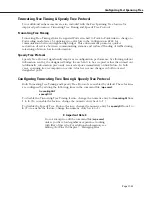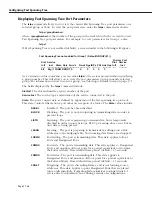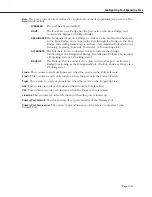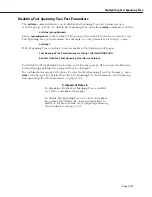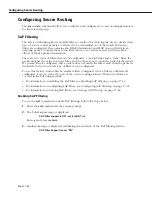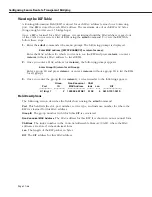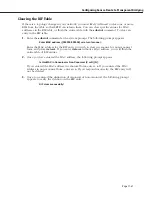
Configuring Spanning Tree
Page 17-33
Field Descriptions
The following section explains the fields displayed by the
stps
command.
Slot/Intf
. The slot and interface (port) number of the port.
Service/Inst
. The service type and instance of the service connected to the port.
Pri.
The value (from 0 to 256) of the priority of the port, 0 being the highest priority.
State.
The port's current state as defined by application of the spanning tree protocol. This
state controls what action a port takes on reception of a frame. The
State
values are:
Disabled
This port has been disabled.
Blocking
This port is not participating in transmitting data to prevent loops.
Listening
This port is preparing to transmit data, but is temporarily disabled to
prevent loops.
Learning
This port is preparing to transmit data, but is temporarily disabled to
prevent loops. This is different from Listening in that the port is acquir-
ing data to facilitate data transmission.
Forwarding
This port is transmitting data.
Some of these values are not available if you are using IBM Spanning Tree. For information
on the differences between IEEE and IBM Spanning Tree, see
Configuring Spanning Tree
Parameters
on page 17-25.
Path Cost.
The contribution of this port to the path cost towards the spanning tree root. The
spanning tree root will include this port.
Desig Cost.
The path cost to the designated port of the segment connected to this port. If this
is the root bridge this value is 0.
Des Port
. The unique port identifier of the bridge port believed to be the designated port for
the LAN associated with the port.
Rt Pt.
This field indicates if this port is the root port. The root port is the port that offers the
lowest cost path to the root bridge.
Swt Pt.
This field indicates if this port is in Optimized Switch Mode. Optimized Switch Mode is
appropriate for dedicated connections to a single workstation or server. For more informa-
tion, see Chapter 19, “Managing Groups and Ports.”
FWD Transition.
The number of times this port has changed from the Learning state to the
Forwarding state.
Root Bridge ID.
The bridge identification number of the root bridge.
Desig Bridge ID.
The unique bridge identifier of the designated bridge for this port (LAN).
Summary of Contents for Omni Switch/Router
Page 1: ...Part No 060166 10 Rev C March 2005 Omni Switch Router User Manual Release 4 5 www alcatel com ...
Page 4: ...page iv ...
Page 110: ...WAN Modules Page 3 40 ...
Page 156: ...UI Table Filtering Using Search and Filter Commands Page 4 46 ...
Page 164: ...Using ZMODEM Page 5 8 ...
Page 186: ...Displaying and Setting the Swap State Page 6 22 ...
Page 202: ...Creating a New File System Page 7 16 ...
Page 270: ...Displaying Secure Access Entries in the MPM Log Page 10 14 ...
Page 430: ...OmniChannel Page 15 16 ...
Page 496: ...Configuring Source Route to Transparent Bridging Page 17 48 ...
Page 542: ...Dissimilar LAN Switching Capabilities Page 18 46 ...
Page 646: ...Application Example DHCP Policies Page 20 30 ...
Page 660: ...GMAP Page 21 14 ...
Page 710: ...Viewing the Virtual Interface of Multicast VLANs Page 23 16 ...
Page 722: ...Application Example 5 Page 24 12 ...
Page 788: ...Viewing UDP Relay Statistics Page 26 24 ...
Page 872: ...The WAN Port Software Menu Page 28 46 ...
Page 960: ...Deleting a PPP Entity Page 30 22 ...
Page 978: ...Displaying Link Status Page 31 18 ...
Page 988: ...Displaying ISDN Configuration Entry Status Page 32 10 ...
Page 1024: ...Backup Services Commands Page 34 14 ...
Page 1062: ...Diagnostic Test Cable Schematics Page 36 24 ...
Page 1072: ...Configuring a Switch with an MPX Page A 10 ...
Page 1086: ...Page B 14 ...
Page 1100: ...Page I 14 Index ...

